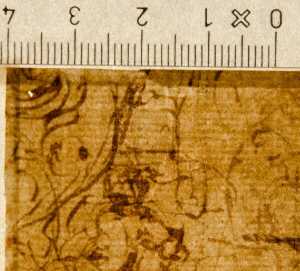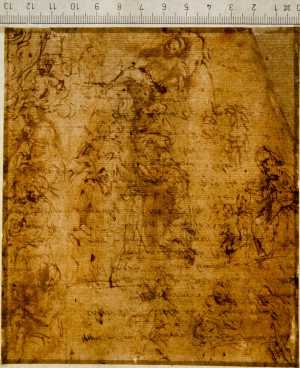Specifications
| Title | Various Studies including a Horseman and a Music-Making Angel |
|---|---|
| Material and technique | Pen and brown ink, brown wash (recto and verso) |
| Object type |
Drawing
> Two-dimensional object
> Art object
|
| Location | This object is in storage |
| Dimensions |
Height 149 mm Width 132 mm |
|---|---|
| Artists |
Draughtsman:
Paolo Veronese (Paolo Caliari)
|
| Accession number | I 39 recto (PK) |
| Credits | Loan Stichting Museum Boijmans Van Beuningen (former Koenigs collection), 1940 |
| Department | Drawings & Prints |
| Acquisition date | 1940 |
| Creation date | in circa 1562-1564 |
| Watermark | fragment circle (25 x 25 mm, above left, on P1 of 4P, vH) |
| Inscriptions | # '5' (above right, pen and brown ink); a list of accounts with the years 1560, 1561, 1562 and 1564 (verso, across whole sheet, pen and brown ink) |
| Collector | Collector / Franz Koenigs |
| Mark | P. Lely (L.2092), R. Houlditch Jr. (L.2144), F.W. Koenigs (L.1023a) |
| Provenance | Sir Peter Lely (1618-1680, L.2092)*, London; Richard Houlditch Jr. (-1760, L.2214)*, London; - ; Franz W. Koenigs (1881-1941, L.1023a), Haarlem, acquired in 1925 (Veronese); D.G. van Beuningen (1877-1955), Rotterdam, acquired with the Koenigs Collection in 1940 and donated to Stichting Museum Boijmans Van Beuningen |
| Internal exhibitions |
De Collectie Twee - wissel IV, Prenten & Tekeningen (2009) |
| Research |
Show research Italian Drawings 1400-1600 |
| Literature | Tietze/Tietze-Conrat 1944, no. 2072, pl 158.2, pp. 343-344; Cocke 1973, pp. 138-139, 147 no. 12, pl 2; Cocke 1984, pp. 134-135, no. 53; Rotterdam 1996, p. 63, under no. 23, fig. 1 |
| Material | |
| Object | |
| Technique |
Washing
> Wash
> Drawing technique
> Technique
> Material and technique
Washing
> Wash
> Drawing technique
> Technique
> Material and technique
|
| Geographical origin | Italy > Southern Europe > Europe |
| Place of manufacture | Venice > Veneto region > Italy > Southern Europe > Europe |
Do you have corrections or additional information about this work? Please, send us a message


























